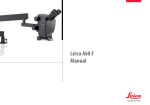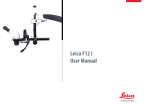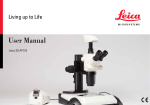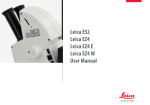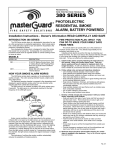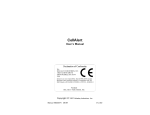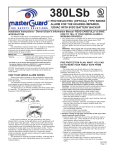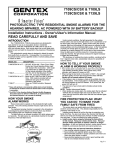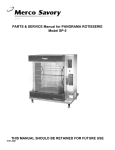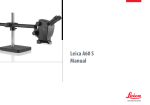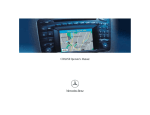Download Leica A60 S Manual - Leica Microsystems
Transcript
Leica A60 S Manual Table of Contents The Leica A60 S Congratulations! An Overview of the Leica A60 S 13 14 Assembling the Leica A60 S Column and Baseplate Safety Ring and Horizontal Arm Grounding Assembling the Optics Carrier Fastening the Leica A60 Assembling the Illuminator 16 17 18 19 20 21 Leica A60 S Using the Leica A60 S Adjusting the Working Height The Correct Interpupillary Distance Focusing Magnification Display Dioptric Correction and Parfocality Adjusting the Resistance of the Focus Drive Leica A60 LED Ring Illuminator Replacing the Protective Glass 23 25 26 27 28 29 30 31 Dimensions Dimensions 33 Optical Data Optical Data 36 Manual 2 Safety Instructions Leica A60 S Manual 3 Symbols used in this operating manual Warning! Safety hazard! This symbol indicates especially important information that is mandatory to read and observe. Failure to comply can cause the following: ϘϘ Hazards to personnel ϘϘ Instrument malfunctions and damage Danger due to hot surface This symbol warns against touching accessible hot surfaces, e.g. those of light bulbs. Important information This symbol indicates additional information or explanations that are intended to provide clarity. Warning of hazardous electrical voltage This symbol indicates especially important information that is mandatory to read and observe. Failure to comply can cause the following: ϘϘ Hazards to personnel ϘϘ Instrument malfunctions and damage Leica A60 S Manual 4 Important Notes Description The Leica A60 S stereomicroscope meets today's state of the art of technology. Nevertheless, hazards may still arise during operation. The potential risks are described below. Before installing, operating or using the instrument, it is mandatory to read this user manual. In particular, please observe all safety instructions. Leica A60 S User Manual This user manual includes important instructions related to operating safety, maintenance and accessories. includes Your Leica A60 S stereomicroscope an interactive CD-ROM with all relevant user manuals. Keep it in a safe place, and readily accessible to the user. You can also download user manuals and updates from our website at www.leica-microsystems.com Manual Legal requirements Adhere to general and local regulations relating to accident prevention and environmental protection. EC Declaration of Conformity Electrically operated accessories are constructed based on the state of the art of technology and are provided with an EC Declaration of Conformity. 5 Instructions on use Intended use The Leica A60 S stereomicroscope is an optical instrument for improving the visibility of objects through magnification and illumination. The stereomicroscope may be used only in closed rooms and must be placed on a solid substrate. The Leica A60 S stereomicroscope can be used in clean rooms. Place of use Use the stereomicroscope in closed, dust-free rooms at +10 °C to +40 °C. Protect it from oil, chemicals and extreme humidity. Install electrical devices at least 10 cm from the wall and away from flammable substances. the In warm and warm-damp climatic zones, individual components require special care in order to prevent the build-up of fungus. 5-15P) or unscrew any mechanical Never install any other plug (NEMA components unless expressly instructed to do so in the instructions. bed in this user manual have been tested The instruments and accessories descri- Always position the stereomicroscope so that you can disconnect the illumination from the power supply at any time. The power cable must remain accessible at all times, because the power cable is intended as a power disconnect device. Leica A60 S Non-intended use Using the stereomicroscope in any way other than that described in the user manual may result in personal injury or damage to property. Doing so can impair the functions of the protective measures provided. for safety and potential hazards. Manual 6 Instructions on use (continued) The responsible Leica affiliate must be consulted whenever the instrument is altered, modified or used in conjunction with non-Leica components that are outside of the scope of this manual! Unauthorized alterations to the instrument or noncompliant use shall void all rights to any warranty claims. Leica A60 S Transport If at all possible, use the original packaging for shipping or transporting individual modules. In order to prevent damage from vibrations, the customer should disassemble all moving parts according to the user manual and pack them separately. Integration in third-party products When installing Leica products into third-party products, the manufacturer of the complete system or its dealer is responsible for following all applicable safety instructions, laws and guidelines. Disposal Disposal must comply with locally applicable laws and regulations. Manual 7 Health risks and dangers of use Health risks Workplaces with stereomicroscopes facilitate and improve the viewing task, but they also impose high demands on the eyes and holding muscles of the user. Depending on the duration of uninterrupted work at such a workplace, impaired vision and problems with the musculoskeletal system may occur. For this reason, appropriate measures for reduction of the workload must be taken: ϘϘ Optimum workplace layout ϘϘ Frequent changes of activity ϘϘ Thorough training of the personnel, giving consideration to ergonomic and organizational aspects Leica A60 S The ergonomic optical design and construction of the Leica stereomicroscopes are intended to reduce the exertion of the user to a minimum. Dangers during use ϘϘ The stereomicroscope must be connected to a grounded outlet. Danger of infection Direct contact with eyepieces is a potential transmission method for bacterial and viral infections of the eye. ϘϘ The stereomicroscope may be used when it is in proper working condition only. using personal eyepieces for each indiviThe risk can be kept to a minimum by dual or detachable eyecups. Manual 8 Information for the person responsible for the instrument Information for the person responsible for the instrument ϘϘ Ensure that the stereomicroscope is used only by persons qualified to do so. ϘϘ Ensure that this manual is always available at the place where the stereomicroscope is in use. ϘϘ Carry out regular inspections to make certain that the authorized users are adhering to safety requirements. ϘϘ When instructing new users, do so thoroughly and explain the meanings of the warning signs and messages. ϘϘ Assign individual responsibilities for starting, operating and servicing the instrument and monitor the observance of these responsibilities. Leica A60 S ϘϘ Only use the stereomicroscope in proper condition. ϘϘ Inform your Leica representative or Leica Microsystems (Schweiz) AG, Industry Division, 9435 Heerbrugg, Switzerland, immediately of any product defect that could potentially cause injury or harm. ϘϘ If you use accessories from other manufacturers with the stereomicroscope, make sure that these manufacturers confirm that the combination is safe to use. Follow the instructions in the user manual for those accessories. ϘϘ Modifications to or service on the stereomicroscope may be carried out only by technicians who are explicitly authorized by Leica to do so. ϘϘ Only original Leica replacement parts may be used in servicing the product. Manual ϘϘ After service work or technical modifications, the device must be readjusted in accordance with our technical specifications. ϘϘ If the unit is modified or serviced by unauthorized persons, is improperly maintained (as long as maintenance was not carried out by us), or is handled improperly, Leica will not accept any liability. ϘϘ The electric installation in the building must conform to the national standard, e.g. current-operated ground leakage protection (fault-current protection) is suggested. 9 Care instructions General Instructions ϘϘ Protect the stereomicroscope from moisture, fumes and acids and from alkaline, caustic and corrosive materials. Do not store chemicals in the vicinity. ϘϘ Protect the stereomicroscope from oil and grease. Never grease or oil mechanical parts or sliding surfaces. ϘϘ Follow the instructions of the disinfectant manufacturer. ϘϘ We recommend concluding a service contract with Leica Service. Leica A60 S Cleaning coated parts and plastic parts ϘϘ Dust and dirt particles should be removed with a soft brush or lint-free cotton cloth. ϘϘ ϘϘ ϘϘ Cleaning glass surfaces Remove dust using a fine, dry and greasefree brush made from hair, by blowing with a squeeze blower, or by using a vacuum. ϘϘ Remove coarse debris with a moistened disposable cloth. ϘϘ Remove dirt using a clean cloth that has been moistened with distilled water. Acetone, xylene or nitro-containing thinners must NOT be used. ϘϘ Remove tough dirt using alcohol, chloroform or petroleum ether. Never use chemicals to clean colored surfaces or accessories with rubberized parts. This could damage the surfaces, and specimens could be contaminated by abraded particles. Manual 10 Accessories, maintenance and repair Accessories Only the following accessories may be used with the stereomicroscope: ϘϘ The Leica accessories described in this user manual. ϘϘ Other accessories, provided that these have been expressly approved by Leica Microsystems as being technically safe in this context. Leica A60 S Maintenance ϘϘ The Leica A60 S stereomicroscope is basically maintenance-free. To ensure that it always operates safely and reliably, we recommend that you take the precaution of contacting the responsible service organization. Repairs and service work ϘϘ Only original Leica Microsystems spare parts may be used. ϘϘ Before opening the instruments, switch off the power and unplug the power cable. ϘϘ Touching the live circuit can cause injury. You can arrange for periodic inspections or, if appropriate, conclude a maintenance contract with them. ϘϘ We recommend concluding a service contract with Leica Service. ϘϘ For maintenance and repair, only OEM spare parts may be used. Manual 11 The Leica A60 S Leica A60 S Manual 12 Congratulations! You have just purchased a Leica A60 S - an excellent choice! The outstanding features of this stereomicroscope are its flexible design, its ease of use and absolutely maintenance-free performance. Sturdy and reliable, it is exceptionally well suited to manufacturing tasks, materials testing, quality control and other industrial applications. Leica A60 S In developing the Leica A60 S, we have placed great emphasis on simple, self-explanatory operation. However, please take the time to read the user manual and the notes on operating safety to learn about all the features and capabilities of your stereomicroscope so that you can use it to its best advantage. Should you have any questions, please consult your local Leica representative. We are gladly at your service! Manual 13 An Overview of the Leica A60 S 1 Column 2 Horizontal arm 3 Locking screw on the cross-member 4 Safety ring 5 Baseplate with grounding point 1 2 6 3 6 Magnification changer (zoom) 7 7 Eyepieces 8 Focusing drive 9 Optics carrier 10 Leica A60 LED Ring Illuminator 4 9 8 10 5 Leica A60 S Manual 14 Assembling the Leica A60 S Leica A60 S Manual 15 Column and Baseplate Instructions for safe assembly Due to the heavy weight of the baseplate, improper use can cause injuries or damage to the surrounding area. Therefore, always request assistance for assembly. Leica A60 S Installing the column 1. Push the tapping screw through the baseplate from below. 3. Screw the column in place using the Allen key provided. 2. Fit the serrated lock washer onto the screw. Manual 16 Safety Ring and Horizontal Arm Installing the Safety Ring The safety ring is the most important safety element of the entire configuration. It protects the horizontal arm against falling down accidentally. Mounting the horizontal arm 1. Push the cross-member with the horizontal arm over the column so that the crossmember lies securely on the safety ring. You can now rotate the horizontal arm in any direction desired. 1. Slide the safety ring over the column and tighten the clamping screw. Fastening the horizontal arm For safety reasons, you should fasten the horizontal arm in place when you leave your workstation. 1. Rotate the horizontal arm into a secure position. 2. Carefully tighten the clamping screw on the cross-member. Leica A60 S Manual 17 Grounding Grounding the baseplate The rear side of the baseplate has a grounding point that you can use to ground the configuration. The grounding cable is not included in the scope of delivery. Leica A60 S Use 1. Connect the grounding cable to the grounding point of the baseplate. Manual 18 Assembling the Optics Carrier Assembly 1. Insert the connecting pin from below into the bore of the horizontal arm. Leica A60 S 2. Fasten the stereomicroscope using the washer and safety screw. Manual Free movement of the stereomicroscope After you have installed the safety screw, the stereomicroscope can be rotated freely. 19 Fastening the Leica A60 Fastening The swing-arm stand is designed so that the Leica A60 S can be moved as desired. However, it may also be logical in some instances to fasten the stereomicroscope in place. 1. Carefully tighten the side clamping screw. This fastens the stereomicroscope in its current position. Leica A60 S Manual 20 Assembling the Illuminator Illuminator assembly The Leica A60 LED ring illuminator is installed with a single screw on the bottom of the microscope. The ring illuminator can be installed in any side position desired to accommodate the personal preferences of left and righthanded users. Assembly 1. Connect the power supply cable to the ring illuminator. 2. Push the ring illuminator as far as it will go and screw it into place. The standard delivery of the illuminator includes two Velcro strips that you can use to guide the cable along the horizontal arm. The optional diffuser is attached and screwed in below the ring illuminator. 3. Connect the power supply to the socket. Leica A60 S Manual 21 Using the Leica A60 S Leica A60 S Manual 22 Adjusting the Working Height D B A Working distance The working distance means the distance between the objective and the specimen in focus. For the Leica A60 S, this is 122 mm. 20 25 5 30 10 10 5x F1 1x 122 mm 30x www.leica-microsystems.com C Help for the setup During setup, use the distance bar provided in the "Quick Start Guide" for orientation: ϘϘ Without illuminator, the distance between 5 F2 Max Safety measures After each time the working height is adjusted, you have to retighten the safety ring. Otherwise, accidental lowering can cause damage to the specimen or stereomicroscope. 20 25 30 100 mm 122 mm 100 mm 1x G2 G1 H Max 122 mm In addition, the focusing arm of the Leica A60 S provides a travel path of 50 mm that is used for focusing on the specimen. This provides you with plenty of freedom to focus on locations with different heights on a printed circuit board, for example. Leica A60 S the bottom section of the microscope and the specimen should be 122 mm. ϘϘ With the illuminator installed, the distance between the bottom section of the illuminator and the specimen should be 100 mm. Manual 23 Adjusting the Working Height (continued) Adjusting the working height 1. Hold the horizontal arm securely and release the safety ring. 3. Tighten the locking screw on the crossmember. 5. Loosen the locking screw on the crossmember so that the horizontal arm can be moved freely again. 2. Move the horizontal arm to the desired height. Leica A60 S 4. Guide the safety ring to the cross-member and tighten the clamping screw. Manual 24 The Correct Interpupillary Distance The interpupillary distance is correctly set if you see a single circular image field when looking at a specimen. the eyepieces together or separate them until you see a circular image. 3. Slowly approach the eyepieces with your eyes until you can see the complete image field without corner cutting. If you are still a novice stereomicroscope user, you may need a short time to become accustomed to this. Not to worry—after a little while, it will become automatic. ✗ If you wear glasses, fold the eyecups back – otherwise, fold the eyecups forwards. ✓ Adjusting the interpupillary distance 1. Look into the eyepieces. 2. Hold the eyepieces with both hands. Push Leica A60 S Manual 25 Focusing microscope using the focusing drive. The Focusing raises and lowers the stereo- specimen is brought into sharp focus as soon as it is in the focal point of the optics. Focusing 1. Set the magnification changer to the lowest level (5). 4. Use the focusing drive for fine focus. remains constant (parfocal) even when After the sharpness has been adjusted, it either left- or right-handed. The focusing drive can be operated changing the magnification levels – as long as you have configured the diopter settings on the eyepiece correctly for your eyes (see page 28) whether the working distance is in the If precise focusing is not possible, check permitted range (see page 23). Leica A60 S 3. Set the magnification changer to the highest level (30). 2. Begin to focus on the specimen. Manual 26 Magnification Display tion on the right-hand rotary knob. You can read the configured magnifica- including object field diameter, refer to For the tables with the optical data, page 36. Leica A60 S Manual 27 Dioptric Correction and Parfocality Parfocality Like all other Leica stereomicroscopes, the Leica A60 S is parfocally matched. The prerequisite for this is the correct setting of the diopters for the respective user. The following adjustments have to be carried out only once by each user. Adjusting 1. Set the dioptric correction for both eyepieces to "0". 2. Select the lowest magnification and focus on a flat specimen. Leica A60 S 3. Select the highest magnification and readjust the sharpness. 9. Look through the right eyepiece and repeat item 8. 4. Select the lowest magnification again, but do not look into the eyepieces. 10. Select the highest magnification and refocus if necessary. 6. Rotate the eyepieces counterclockwise in the "+" direction as far as they will go (+5 diopter settings). Now, if you adjust the magnification from the highest to the lowest level, the specimen is always brought into sharp focus. If not, repeat the process. The microscope is now parfocally matched to your eyes. 7. Look through the left eyepiece only. 8. Turn the eyepiece slowly in the “–” direction until the specimen appears sharp. Manual 11. Write down your values and configure them BEFORE each time you begin work. Check the diopter settings at regular intervals. 28 Adjusting the Torque of the Focus Drive Adjusting the torque Is the focusing drive too easy or too difficult to adjust? No problem - the torque can be adjusted individually depending on your personal preferences: 1. Grip the drive knobs with both hands and turn them towards each other until the desired torque is reached during focusing. Leica A60 S Manual 29 Leica A60 LED Ring Illuminator The light of the Leica A60 LED ring illuminator can be very bright. Therefore, always switch on the illuminator before you look through the eyepieces! Avoid looking directly into the LEDs. Leica A60 S number of advantages you will not want The ring illuminator offers a great to do without: ϘϘ Constant color temperature (daylight) throughout the entire lifecycle ϘϘ Long service life of up to 50,000 hours on average ϘϘ Absolutely maintenance-free; no lamp replacement required. ϘϘ Extremely low power consumption Manual Using the keypad ϘϘ Use the button to switch the illuminator on or off. ϘϘ Use the and buttons to adjust the brightness in 10 increments. ϘϘ Touch either of the two buttons to adjust the quantity of light in small increments. ϘϘ Hold the button pressed to change the quantity of light more quickly. 30 Replacing the Protective Glass The protective glass protects the optics from dirt and possible damage. Never use the Leica A60 without the protective glass, as otherwise dust and dirt can get into the optics. consumable. Order number: 10 446 324 The protective glass is considered a Replacing the Protective Glass 1. Remove the Leica A60 LED ring illuminator (see page 21). 2. Remove the protective glass by carefully turning the bottom of the stereomicroscope. Make sure to install the new protective glass as quickly as possible and at a clean location so that no dust or dirt can get inside the microscope. 3. Screw in the new protective glass. Leica A60 S Manual 31 Dimensions Leica A60 S Manual 32 Dimensions 500 356 257 ø 35 402 ø 34.8 176 32 100 384 174 192 230 792 266 792 Leica A60 S Manual 33 Optical data Leica A60 S Manual 34 Optical data Optical data: Zoom Position Total Magnification Object Field Diam. mm Depth of Field* 0.5 5.0 46.0 13.62 0.63 6.3 36.5 9.03 0.8 8.0 28.8 5.89 1.0 10.0 23.0 3.96 1.25 12.5 18.4 2.66 1.6 16.0 14.4 1.71 2.0 20.0 11.5 1.15 2.5 25.0 9.2 0.76 3.0 30.0 7.7 0.54 * according to Berek Leica A60 S Manual 35



































